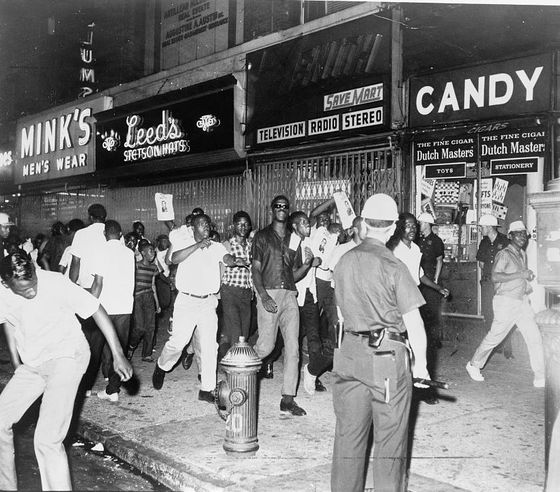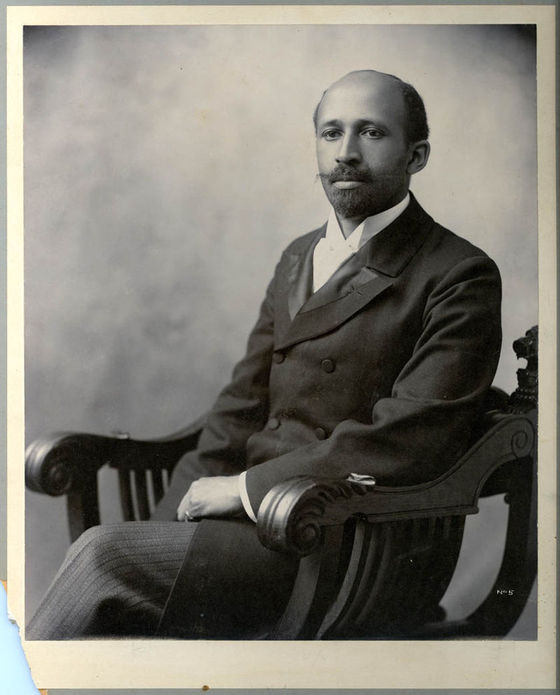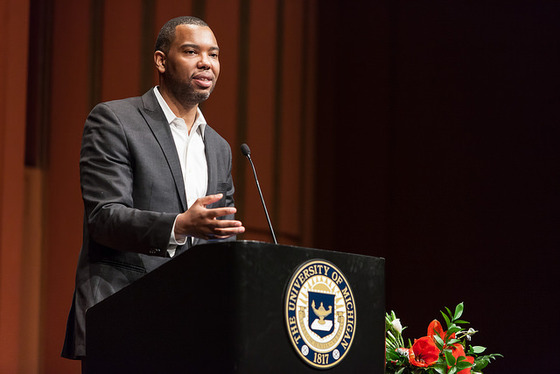May 1, 2016 — Sometime last fall, I received an email from a Harvard colleague inviting me to join a reading group of Ta-Nehisi Coates’s Between the World and Me. “I just had an image this morning of a room full of white people discussing the book,” she wrote, before clarifying in the next line: “I certainly don’t mean to say, ‘come explain what it’s like to be black to us.’” But of course, in some way, that is precisely what she meant.
Amid protests against racialized police violence and debates over the limits of free speech on increasingly diverse college campuses, a good many (often, white) progressives have been left scratching their heads. What explains the current upswell of black Americans’ frustration, just eight years after the election of the nation’s first black president? Black intellectuals like Coates—perceived to be authentic interpreters of the black experience—have been recruited to make sense of the disillusionment. That Coates is both black and a native son of Baltimore’s restless inner city only heightens his authenticity in the eyes of a white liberal public searching for answers. But even I—the suburban-raised son of two black physicians—carry a certain racial authenticity, one seemingly much desired in predominantly white academic spaces.
Where does this belief in, and demand for, racially authentic explanations of black life come from? Far from unique to this contemporary moment, the notion of a racially authentic interpretation of blackness has been a mainstay of American understandings of the role of black intellectuals for more than a century. Through different routes, two recent books explore the centrality of racial authenticity in black intellectual practice—or, the belief in a uniquely and authoritatively black knowledge produced by black scholars, writers, and artists. In his book On the Corner, Daniel Matlin considers how Kenneth Clark, a psychologist, Amiri Baraka, a writer, and Romare Bearden, an artist, variously navigated their designations as “indigenous interpreters” for white audiences in the 1960s. Similarly, in his book The Scholar Denied, Aldon Morris explores black intellectual practice, but during a time when many white audiences expressed little interest in the insights of black intellectuals, even of the preeminent W. E. B. Du Bois. Placing these books in conversation illuminates the costs and benefits of racial authenticity in the production of knowledge about black America and, ultimately, in the struggle to alter the course of American racial inequality.
The 1960s marked a turning point in the position of black intellectuals with respect to white progressives, Matlin argues. The migration of African Americans from the South to major cities in the North and Midwest in the mid-20th century resulted in a massive geographic—and symbolic—relocation of black America. The terms “ghetto” and “urban” came to signify a population that had, for successive generations, been exploited and contained in the rural South. But migrants’ lofty expectations of northern prosperity were tempered by the realities of dilapidated housing, a declining manufacturing sector, and more modern, less strident forms of racism. The cities grew restless. Various white audiences looked to black intellectuals—whom Matlin describes as racial “insiders” with “experiential knowledge”—to make sense of the emerging black ghettos and the attendant appeal of the Black Power movement’s politics of racial separatism.
On the Corner opens during the Harlem riot of 1964. During a racist altercation between a white man and several young black students on Manhattan’s Upper East Side, James Powell, a black boy, was shot dead by Thomas Gilligan, a white police officer. Protests lasted several days. As the summer progressed, similar protests against police brutality engulfed cities from Philadelphia to Rochester. To many observers, the perils of the northern black ghettos were fast eclipsing the promises of the southern civil rights movement, which had dominated media coverage in the preceding decade.
It was “amid the riots” that cultural arbiters such as newspaper editors, theater producers, and policymakers sought out black intellectuals to interpret “black urban life to the white American public.” For these cultural arbiters, the racial identity of black intellectuals—in addition to their intellect and disciplinary training—was fundamental to the legitimacy of their claims about and solutions to black urban crises. “The logic of racial authenticity,” Matlin writes, “stipulates both that black intellectuals have a particular responsibility to represent, in both senses of that word, ‘their’ people, and that, as racial insiders, they are uniquely capable of doing so.”
As much as it has been imposed by white audiences, the logic of racial authenticity has been articulated by black publics and intellectuals as well. Intellectuals as disparate as Du Bois and Baraka argued that blacks possessed not only intimate understandings of blackness but also the moral authority to speak first on the social problems facing black ghettos. In the 1960s white liberals imbibed these dual claims, fostering a veritable marketplace for the “pronouncements of those believed to possess both intimate knowledge of black life and the ability to articulate that knowledge to a broad white public.” This marketplace boosted the careers of many black intellectuals of the time. Black scholars, writers, and artists were invited to the White House and regularly asked to provide their perspective on myriad black urban crises, large and small, in the form of interviews, essays, art exhibitions, and social science research.
But there were costs, too. Matlin reveals how Baraka, Bearden, and Clark each experienced ambivalence, at one point or another, toward their roles as indigenous interpreters. The story of Kenneth Clark paints the clearest portrait of what it meant for black intellectuals to feel “cornered” by the logic of racial authenticity.
WHERE DOES THIS BELIEF IN, AND DEMAND FOR,
RACIALLY AUTHENTIC EXPLANATIONS OF
BLACK LIFE COME FROM?
Throughout his career, Clark would maintain that interpreting for white audiences was critical to social change. The psychologist who, with his colleague and wife Mamie Clark, provided social science evidence undergirding the Supreme Court’s assertion in Brown v. Board of Education that segregation was damaging to the psyche of black children, Clark witnessed firsthand the impact his scholarship could have on social policy. In his 1965 book Dark Ghetto, Clark sought to “lay ‘the truth of the ghetto’ before the white American public and to explain the meaning of the riots to white liberals perplexed and disturbed by this violent turn.” Social change, he believed, would come about only by appealing to the compassion of the “ruling white majority” through the dramatization of the “injustices of segregation and poverty.” While other black intellectuals, such as Ralph Ellison, criticized Clark for pathologizing the black ghetto, Clark found such an accounting to be not only accurate but also practical in the struggle for white sympathy.
But Clark would later grow disillusioned. The Johnson administration’s War on Poverty ultimately failed black ghettos, and local politicians chose to treat urban unrest as a crime problem requiring police suppression rather than as a social problem requiring welfare state intervention. Clark came to view white elites as unwilling to enact needed social reform. At the same time, he began to wrestle with his intellectual identity, struggling to define himself outside white audiences’ expectations. When elected in 1969 to serve as the first black president of the American Psychological Association, Clark felt pressure to give a presidential address that spoke to general, as opposed to only black, psychological and social processes. The resulting address—which advocated for the use of psycho-technological drugs among political leaders to inhibit their potential to abuse power—proved disastrous. Clark would later lament that his address failed not necessarily because his ideas were anathema but, at least in part, because his colleagues expected him to speak only on issues of race or civil rights—the intellectual domain “reserved for blacks.”
The ambivalence of 1960s black intellectuals about serving as authentic indigenous interpreters could, perhaps, appear overwrought, particularly when considered in contrast to the persistent marginalization faced by many black intellectuals prior to the urban crises of the 1960s. Indeed, Morris’s book The Scholar Denied affords us insight into a historical moment when white audiences—especially within academia—often ignored, rather than sought out, the experiential expertise of black intellectuals. In particular, Morris details how white sociological and public audiences marginalized the scientific contributions of the sociologist W. E. B. Du Bois and other black social scientists working at the historically black Atlanta University in the early 1900s.
For Du Bois and his colleagues, their racial identity as black delegitimized their scientific scholarship on race, rather than serving as proof of its authenticity. Even at the height of his sociological career, Du Bois faced numerous hurdles in his attempt to secure research funding from predominantly white institutions. For decades, he struggled to fund his Encyclopedia of the Negro—a project that was ultimately undermined by several white scholars, including the anthropologist Melville Herskovits, who served on the project’s advisory board and expressed doubts to potential funders about Du Bois’s scientific objectivity, given his blackness. Morris writes that Herskovits believed that “black scholars could not be trusted to conduct objective scholarship on blacks and race because they were too emotionally engaged with these topics and because they violated the basic scientific law not to mix activism with scholarship.”
Du Bois’s marginalization from sociology was a matter of racial politics as much as racial identity, as evidenced by the relative status of Booker T. Washington with respect to white audiences within and outside academia. A conservative educator, Washington was arguably the first “black public intellectual,” serving as a “trusted informant to communicate to whites what the Negro thought, felt, wanted, needed.”1 Washington successfully courted white benefactors to fund the historically black Tuskegee Institute and even dined with President Theodore Roosevelt. Within the academy, his expertise was legitimated despite his lack of social scientific credentials. Telling is Morris’s recounting of how the economist Walter Willcox once sought Washington’s conjectural, unscientific confirmation of Willcox’s data on black wealth over Du Bois’s data-driven criticisms. Morris also devotes many pages to detailing Washington’s close relationship with Robert E. Park, one of the central figures of the Chicago school of sociology, who worked as Washington’s assistant at Tuskegee before moving on to the University of Chicago. Washington’s conservative racial politics, as Morris reveals, both aligned with and shaped (through his tutelage of Park) white academic and public views on the wisdom of Jim Crow racial segregation. In contrast to Washington, Du Bois advocated for the social and political integration of blacks, based on his assessment that racial inequalities resulted not from biological inferiority but from white racism and concomitant black cultural deficiencies. With such politics, Du Bois and his colleagues were viewed by Washington and Park as “arrogant snobs who promoted their unwise abstract notions as the solution to the race problem.”
While Du Bois’s race, politics, and perceived elitism served to delegitimize his contributions to science, his insights, ultimately, had an important influence on the burgeoning racial politics of the mid-20th century. In reading Morris’s account, it is often easy to forget that, despite his marginalization within the academy, Du Bois was well-recognized as a social activist whose indigenous insights authentically articulated the experiences and desires of a certain segment of black Americans. Through his involvement with the Niagara movement and the NAACP, Du Bois and other intellectuals such as William Monroe Trotter and Ida B. Wells planted the then-radical seeds for the political activism of the civil rights movement. Although such activism threatened to undermine Du Bois’s scientific authority, white social scientists who believed their whiteness lent them greater objectivity in the study of race nevertheless relied on Du Bois’s insights. For instance, Park, according to Morris, appropriated Du Bois’s concept of double consciousness. Meanwhile, the Swedish economist Gunnar Myrdal’s 1944 work An American Dilemma—often cited as a landmark study of American racial injustice—owes a debt, acknowledged by Myrdal himself, to Du Bois’s The Philadelphia Negro.
For white social scientific audiences of the early 20th century, authentic indigenous understandings of the black experience served merely to confirm, or at best inform, scientific research rather than functioning as legitimate forms of scientific knowledge in their own right. It was believed that racial authenticity amounted to scientific bias—in the case of Washington as much as in the case of Du Bois. Washington’s relative success with white audiences—scientific and lay—says more about these audiences’ willingness to accept his moderate politics of black humility than their legitimation of his scientific or intellectual expertise. Indeed, Washington’s much-promoted separate-but-equal politics rests on a notion of distinct racial difference, similar to that which undergirds the logic of racial authenticity in knowledge-making. In this sense, Washington’s audiences were perhaps doubly prepared to legitimate his interpretations of blackness. Of course, the irony of white academics’ framing of Du Bois as biased is that Du Bois was the first American sociologist to collect systematic empirical data on black social life, at a time when white social scientists found the empirical study of blacks largely unimportant. In his 1898 essay “The Study of the Negro Problems,” Du Bois lambasts his contemporaries’ thin investigations into black communities:
A college graduate sees the slums of a Southern city, looks at the plantation field hands, and has some experience with Negro servants, and from the laziness, crime and disease which he finds, draws conclusions as to eight millions of people, stretched from Maine to Texas and from Florida to Washington.2
By contrast, Du Bois’s multimethod approach to data collection while at Atlanta University was so pathbreaking, Morris argues, that it served as a model for later studies conducted by the US Department of Labor in the early 1900s.
Thus an important difference between the white audiences of the two time periods appears to be the purpose for which they sought the knowledge they understood to be authentically black. Matlin describes 1960s white audiences as seeking both to understand and manage the problems of the emerging black ghettos. White progressives, buoyed by the hope of the civil rights movement and pressured by the radicalism of Black Power, were open to the politics and activism of racial progress. Or, at the very least, they were open to indigenous solutions for managing the black ghettos, whose welfare, it seemed, was beginning to impinge on their own well-being. But early 20th-century white audiences, as Morris describes them, were seeking neither racial progress nor the management of urban crises. For these earlier audiences, the race problem was a distant one, requiring not political or social inclusion but instead a good-faith effort on the part of the Southern black masses to uplift themselves through moral and industrial cultivation.
Since the 1960s, the logic of racial authenticity in the production of knowledge has blossomed both within and beyond the confines of black intellectual practice—with contradictory consequences. On the one hand, the belief in an authentic black form of knowledge has fostered inclusion. Workplaces recruit minority employees with the understanding that diverse perspectives are good for the bottom line, and the most rigorous white academics have come to interrogate the potential limitations and biases of their whiteness, particularly when documenting the conditions of the black urban poor. On the other hand, the belief in authentic black knowledge has also been the foundation on which new justifications for the exclusion of people of color have been built. Since the late 1970s, for example, affirmative action has become justified as a compelling state interest not because people of color face unique disadvantages or because integration is an absolute good, but because minorities are understood to have inimitable perspectives to contribute—but only in certain contexts. Minorities’ experiential knowledge has thus come to be valued only when such knowledge enlightens white audiences. Thus, in oral arguments in the latest affirmative action court case, the Chief Justice of the United States Supreme Court can legitimately ponder: “What unique perspective does a minority student bring to a physics class?”
For his part, Coates, one of today’s most recognized black intellectuals, has expressed skepticism about writing for the enlightenment of white audiences. During a public conversation in New York this past October, he remarked that he never “set out to accumulate a mass of white fans,” going on to observe that when black intellectuals have sought to interpret for white audiences, they have often, seeking not to offend, done so in a way that obfuscates more than clarifies their understanding of racial injustice. Coates’s sentiment echoes that of a new generation of unapologetic black activists and intellectuals who, with their impenitent positioning of white supremacy as the root cause of racial inequalities, have garnered the attention, and resentment, of great numbers of whites. As history reveals, sympathetic attention does not always translate into policy. Even when it does, long-term social change can be elusive. It is disheartening how familiar the 1964 police killing of James Powell in Harlem appears to us today, in 2016, as images of police brutality dominate our daily newsfeeds.
For more than a century, black intellectuals from various disciplinary backgrounds and political positions have articulated their insights on racial injustices. Some have played their role as indigenous interpreters faithfully and with an unfailing optimism, while others have grown wary of bearing witness, of explaining the array of emotions and events—from tragedy and rage to humor and brilliance—that constitute the black American experience. Matlin writes that depicting oppressed people “in a manner that both witnesses the extent and consequences of their suffering and simultaneously recognizes their dignity, resourcefulness, and agency remains an intractable problem for social scientists, artists, and historians.” But the representation of black subordination—no matter how carefully constructed—must also find a receptive audience. So much black intellectual energy has been expended on convincing white audiences simply to care about the exploitation of the black poor and the alienation of the black middle classes. The receptivity of particular white audiences has fluctuated over time, and with it—in tandem, arguably—various indicators of racial inequality. Perhaps just as pressing, then, as interpreting blackness for white audiences is interpreting the causes and consequences of white attention for the rest of us.
>via: http://www.publicbooks.org/nonfiction/black-intellectuals-and-white-audiences





